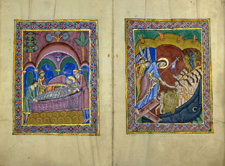Image
© Hildesheim, St Godehard |
THE ENTOMBMENT
Matthew 27:30; Mark 15:46; Luke 23:53; John 19:38-40
The scene takes place in a domed edifice. Christ’s naked body, wrapped
in a transparent shroud is lowered into a strigillated sarcophagus. Mary
stands behind the sarcophagus bending over her son, her arched back parallel
to the dome above. Joseph of Arimathea holds Christ’s shoulders
while two younger men are at his feet, one of them, probably Nicodemus,
holding a jar.
Although the scene appears to take place within a building, the columns
are all behind the characters which suggests it is more like a stage set,
the ‘monumentum’ mentioned in liturgical plays (Young, 1933,
I, 309). Although the gospels clearly say the tomb was cut into the rock,
a stone sarcophagus begins to appear in western depictions from the 10th
century. The sarcophagus also served as an essential and convenient prop
in liturgical plays.
A close parallel for this scene is found on the wall paintings of St Angelo
in Formis, Italy. It shows the domed structure, the strigillated sarcophagus,
the wrapped body, but Mary is placed on the right, by Christ’s head.
The position of her body parallel to Christ, as a lamentation, is found
in the Byzantine Vatican MS. Vat. Gr. 1156, f194v.
Mary’s lamentation at the entombment derives from the apocryphal
Gospel of Nicodemus, popular in the Byzantine church. (AP, 72,
pl 112 c and f).
Quire 3.
Thread or stitch holes for protective curtain

Click
to enlarge
|
![]()